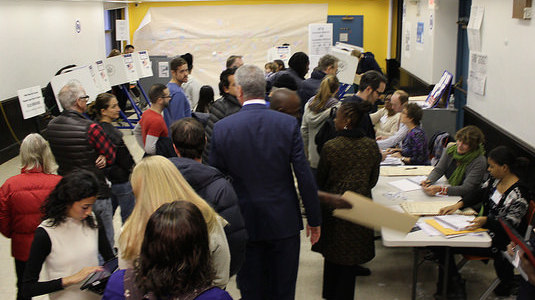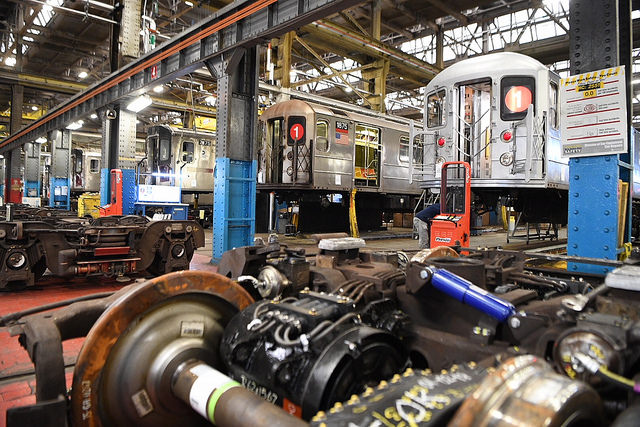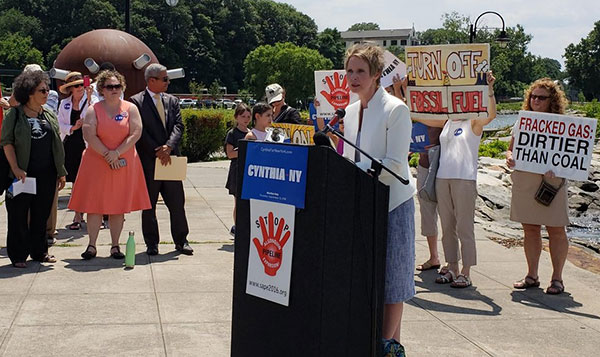An Opportunity to Offer Real Election Reform in New York City

(photo: Gotham Gazette)
Last Tuesday during the Ohio-12 special election, Americans found themselves angry at third party voters – again – for “wasting” their votes.
This problem is not unique to Ohio: in multi-candidate competitive races, we see upset voters of one party or candidate hold others accountable for their loss.
The blame should not be placed on voters -- it should be on the broken election system. Just look at New York City.
New York City primaries are crowded fields, with sometimes with as many as seven people vying for one ballot line.
Since 2009 there have been 121 primary elections in the city; 33.8% of these primaries were two-candidate races and 66.1% were more-than-two-candidate races.
Just during last year’s primary election cycle alone there were 38 elections. While 17 of these primaries had two candidates, the remaining 21 races had more than two candidates.
Of those 21 races, roughly 61.9% were won with less than 50% of the vote.
By supporting Ranked Choice Voting in New York City, Mayor de Blasio can help end the blame game.
Ranked Choice Voting allows voters to rank candidates from first to last choice on their ballots.
A candidate who collects a majority of the vote wins. If there’s no majority, then the last-place candidate is eliminated and their votes re-allocated according to the second preference of their voters. The process is repeated until there’s a majority winner.
It provides many benefits to voters, building majority support for candidates in multi-candidate races, inspiring voters to vote their preference - not the lesser of two evils - and avoiding costly run-offs.
Constituents are best served when their elected representative is able to garner majority support, while the elected official benefits from a broader base of support as well.
Ranked Choice Voting would avoid the troubling pattern of anti-democratic electoral outcomes in New York City. Candidates would move to the general election with majority support from their district.
Right now, the mayor’s Charter Revision Commission is reviewing recommendations before making proposals for the November New York City ballot. The 15-member commission has the opportunity to help transform the way New Yorkers vote.
History has its eyes on the them.
***
Susan Lerner is the executive director of Common Cause-NY. On Twitter @commoncauseny.
***
Have an op-ed idea or submission for Gotham Gazette? Email This email address is being protected from spambots. You need JavaScript enabled to view it.
Federal Corporate Tax Cuts Just Gave New Billions to New York Businesses - What About the MTA?

(Photo: Don Pollard/Office of Governor Andrew M. Cuomo)
There is a sudden new source of money in New York that is getting little attention in the debate about where the MTA will get resources to fund the ambitious plans to solve its problems, let alone just manage to keep the mass transit system going. That source is the big corporate income tax cuts just enacted by the federal government that have put billions - yes, billions - of dollars into the hands of New York businesses and their owners.
There are several reasons why tapping this resource makes sense. First, the size of the cash savings to New York businesses is so large that utilizing even a billion dollars a year would just be a portion of the money newly sitting in corporate pockets, even if restricted to businesses in the New York City area. Second, unlike individual income and property taxes, business taxes remain fully deductible at the federal level. Third, the mass transit systems that deliver millions of workers to these businesses are the lifeline for that wealth, and the state’s businesses should participate in a responsible effort to address this issue, as they did in 2008 when New York business leadership supported a payroll tax.
Still, Congestion Pricing Must Stay on The Table
Consideration of this revenue source is by no means intended to exclude congestion pricing, which will return to the table early in 2019, during state budget negotiations. The truth is that the MTA needs twice as much, or more, than the revenue congestion pricing can deliver. The congestion pricing plan developed by the “Fix NYC” panel put together by Governor Cuomo includes a Manhattan business district entry fee that would total about $1 billion a year (excluding the new taxi/app-vehicle tax, which was enacted). But to pay for the MTA’s current capital plan, and then pay for the new “Fast Forward” plan put forth by MTA New York City Transit President Andy Byford on top of it, will require double the size of the congestion pricing fee, and more.
The MTA itself made the case at its end-of-July board meeting. The presentation of the July 2018 MTA Financial Plan update and the 2019 Preliminary Budget began with this overriding statement: “As stated in the November and February plans, the MTA requires new sources of sustainable revenue for operations and capital.”
The board heard the dry numbers that predicted growing operating deficits from 2020 to 2022 despite 4% fare and toll hikes in 2019 and 2021. The deficit is projected to be $200 million in 2020, $400 million in 2021, and $600 million in 2022. A few weeks before the board meeting, Governor Cuomo reiterated his support for congestion pricing and said the MTA needed $37 billion, the necessary portion of which he proposed the state split with New York City. This is political rhetoric. Neither Cuomo nor de Blasio wants to divert resources from their budgets to provide steep new revenue sources to the MTA. New sources of money are required.
The MTA’s Problem
The main problem with paying for mass transit is the MTA capital budget. The MTA can manage to cover the expenses of its operating budget within the constraints of fares, tolls, and dedicated taxes, but not its capital budget.
The money needed to replace track, stations, rolling stock, legacy signals, advanced signals, the expansion projects, and more requires external funding sources. The capital budget needs government grants and/or borrowed funds. Borrowed funds means paying interest, and that is a major, growing issue. When you need $37 billion, and most of it won’t come from grants, that’s a lot of borrowing and a lot of interest to pay. Congestion pricing is a necessary and essential step - but the billion dollars a year from it can pay interest on only $12 to $15 billion worth of borrowed funds. That means you’re not even halfway to $37 billion.
How much new cash is businesses in New York saving from the federal income tax cuts? The New York State Tax Department knows the answer because New York’s corporate income tax is computed using the federal corporate income tax as the starting point in a business’ own New York tax filing. It will take some time to get that answer, so some back-of-the-envelope calculations are in order.
How Much New Money Is Available?
The New York State economy is 8% of the nation’s Gross Domestic Product. Federal corporate income tax receipts in fiscal year 2017 (before the Trump-led cut) were approximately $300 billion. New York’s contribution to the federal receipts can be simply computed at 8% of that, or $24 billion. The federal corporate income tax just got cut 40%, going from 35% to 21%, 14 full percentage points. Federal tax savings have therefore put about $9.6 billion in new cash annually into the pockets of New York corporations, not adjusting for year-to-year fluctuations. How much of that is in the MTA region -- New York City and its suburbs?
A study of New York’s regional tax and spending distribution was conducted by the Rockefeller Institute in 2011 using the state’s 2009-2010 fiscal year. That study showed that 89% of the bank income tax, and 79% of the corporate franchise tax, came from New York City and its suburbs. The figures are higher now because economic activity has become even more concentrated downstate since 2009. An estimate that close to 85% of the corporate profits taxes come from downstate is reasonable, meaning roughly $8 billion a year in new money to the region’s businesses from the federal reduction.
Some of this money is not New York taxable income -- New York tax law counts out profits from sales of products and services outside New York pursuant to a formula -- but a very large proportion is New York profit. Maybe half? The New York Tax Department knows the answer.
A surcharge on corporate tax liability related to New York corporate taxable income has been in place since the first MTA bailout put together by Governor Carey and the Legislature in 1982. Today it yields $1.2 billion in dedicated tax revenue to the MTA as part of the Metropolitan Mass Transit Operating Assistance Account (MMTOA). This is New York’s own tax, not related to the new cash from the federal tax cut. But the fact is that New York State has been taxing corporate profits for the MTA for 35 years.
New York business leadership proposed a payroll tax in the MTA district in 2008 and it was enacted in 2009. The tax was unpopular, especially in the New York City suburbs. Governor Cuomo later scaled back the payroll tax in 2011 to exempt smaller businesses and organizations. It is still a major source of money for the MTA, but a separate New York 2014 corporate tax cut resulted in unexpected revenue losses for the state as a whole.
New York’s Own Corporate Tax Cut Problem
In 2014 Governor Cuomo proposed cutting the state corporate income tax from 7.1% to 6.5%, as well as merging the corporate franchise and bank income taxes. The merger was supposed to be revenue neutral. The Legislature approved the proposal and added a repeal of the corporate income tax on New York manufacturing. Something has since gone wrong from this change. New York’s corporate income tax revenue has declined precipitously since 2015.
| (in billions) | FY 2013 | 2014 | 2015 | 2016 | 2017 | 2018 |
| Corporate Franchise Tax | 3.009 | 3.812 | 3.548 | 4.527 | 3.166 | 3.08 |
| Bank Tax | 1.912 | 1.05 | 1.536 | 121 | 389 | 467 |
| Total | 4.921 | 4.862 | 5.084 | 4.406 | 3.555 | 3.547 |
The State Division of the Budget explained the sharp drop off in revenue from the combined corporate franchise and bank taxes from overpayments in 2015. But the drop off is steep: $1.3 billion, or 28%, for 2018 compared to back five years ago in 2013, before the reforms were enacted. The result of the reform was serious revenue losses.
Regardless, mass transit is in crisis and there are many, many billions of new dollars from the federal corporate tax cuts. And some New York profits that had been taxable seem to have fallen off the table since a flawed reform in 2014 as well. These corporate tax savings ought to contribute to the mass transit solution.
***
Jim Brennan was a member of the New York State Assembly for 32 years, where he chaired four committees. On Twitter @JimBrennanNY.
***
Have an op-ed idea or submission for Gotham Gazette? Email This email address is being protected from spambots. You need JavaScript enabled to view it.
Terrified About Climate Change? Vote Cynthia Nixon

Cynthia Nixon (photo: @CynthiaNixon)
Governor Andrew Cuomo seeks to portray himself as a leading environmentalist. But in reality, he is too wrapped up in his own political ambitions to be the 21st century climate champion New York needs.
The surface is rosy. Governor Cuomo formed the impressive sounding U.S. Climate Alliance, he banned fracking (while building infrastructure to transport fracked gas from nearby states) and is expanding wind farming in the state.
Take a closer look, however, and it’s much seedier.
While portraying himself as a climate leader, Cuomo is hoarding hundreds of thousands of dollars that he has accepted from fossil fuel companies in his campaign war chest. Recently, after facing pressure from constituent advocates and Cynthia Nixon’s candidacy, he said he would no longer accept fossil fuel-funded donations. But then he walked back that pledge, saying he misheard a question, and signaling that he is more concerned with financially positioning himself to run for President -- let’s be honest: he does not need $30 million to run for Governor -- than the wellbeing of his constituents.
With thousands of New Yorkers still recovering from Hurricane Sandy, wildfires scorching the West, and Puerto Rico still not recovered from Maria, there is no excuse for a Governor who claims to be a climate champion but accepts blood money from the fossil fuel industry.
Governor Cuomo has also refused to publicly support the Climate and Community Protection Act, which would shift New York off fossil fuels to a 100% renewable economy by 2050 and has the support of over 100 unions, community groups, and advocacy organizations across New York State. The CCPA has passed the State Assembly multiple times, but has stalled in the Senate, partially due to lack of support from the Governor. When asked about the legislation’s provision for completely shifting New York state to renewable energy over the next 30 years, he insisted it isn’t “practical” to make that rapid a transition.
Polar ice caps will not stop melting to accommodate Andrew Cuomo’s political ambitions nor his sense of practicality. Ask any scientist, and they will tell you that we no longer have time for an incremental approach to climate change. As climate leader Bill McKibben has said, with climate change, winning slowly is the same as losing.
Cynthia Nixon is running on a bold climate action agenda that includes supporting both the Climate and Community Protection Act as well as the Climate and Community Investment Act, which would levy a tax on corporate polluters, generating billions in revenue for investment in renewable energy, green jobs, and resiliency. Most important, Nixon is putting her money where her mouth is -- from the start of her campaign, she has refused all funding from the fossil fuel industry.
Climate consequences are here and only getting worse. Hurricanes supercharged by warming oceans, drought, heat, wildfires, flooding, rising sea levels: it is all underway. Over time, New York will suffer increasingly frequent and devastating storms and floods. Coastal towns will erode into the ocean. Changing weather patterns will impact everything from farms, fisheries, and our food supply to tourism, housing, transportation, and public health.
We need bold, transformative leadership and we need it now. With Donald Trump in Washington, New York needs to aggressively pave its own way into an uncertain, climate-altered future. Cynthia Nixon wants to lead us there by rejecting fossil fuels, protecting vulnerable communities, and embracing a shift to a fairer, renewable energy economy. Andrew Cuomo wants to fill his wallet and run for President.
***
Liat Olenick is a public school science teacher, union leader, and co-president of non-profit Indivisible Nation BK. On Twitter @Liat_RO of @bkindivisible
***
Have an op-ed idea or submission for Gotham Gazette? Email This email address is being protected from spambots. You need JavaScript enabled to view it.




